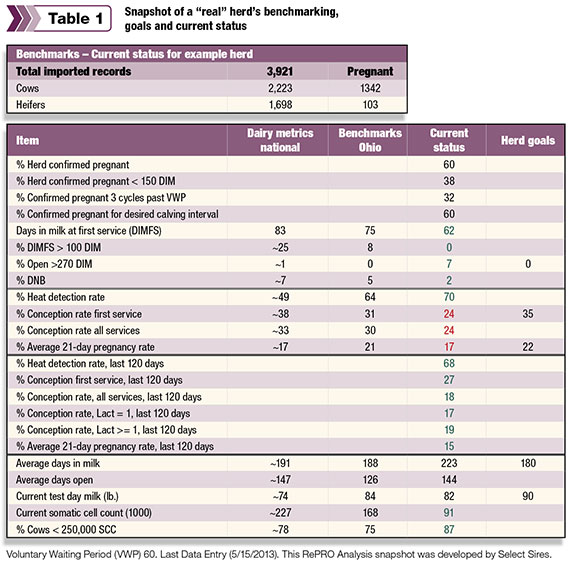Reproductive performance of a dairy herd is a function of certain management policies and how well these are implemented in daily herd management. It has long been known that there is an important economic advantage to be gained by efficient reproduction in dairy herds.
The ability to use records effectively is a cornerstone of reproductive management. Accurate records are necessary to obtain the history of past performance and determine if changes or adjustments need to be made in current management policies.
However, one must use good judgment with monitoring to avoid changing something that is not really a problem. Change should occur as needed or warranted and not just for the sake of change.
Many parameters can be used to monitor reproductive status and trends within the dairy herd, but every parameter monitored should be proactive, measurable and result in profit to the dairy.
Goals are target levels of performance toward which managers are striving.
Complete herd records should provide the necessary tools to define herd performance history, assist in establishing goals for monitored parameters and assist in determining the impact of the plan developed to reach the established goals.
Goals should not be static but change once reached to achieve higher performance.
Benchmarks are standards by which performance can be measured or compared, and are not synonymous with goals.
They are simply the averages for different monitoring parameters and may be derived by grouping together herds that represent specific categories (herd size, production level or geographic location, for example).
A key performance indicator (KPI) is a metric that a dairy may use to gauge performance and whether future performance will be a success or failure.
There are many KPIs that can be used to proactively predict where a herd’s reproductive performance is headed. Revealing a potential problem, discussing it and implementing corrective measures are always better than attempting to react after the fact.
Recently, when I asked a producer what his goals were, I received the answer that should be the response every time: “To be profitable.” I believe reproductive performance goals should be herd-specific, but cost should always be considered.
Is it a goal to utilize fixed-timed A.I. and only inseminate cows on Thursday, or is the goal to minimize hormone administration by using either “chalk and walk” or an activity system? Every dairy should have the goal of efficient pregnant cow production.
Benchmarking, as stated above, is not the same as having goals. The most flexible data set I am aware of is DairyMetrics, available from the DRMS processing center in Raleigh, North Carolina.
You can select your individual herd information and compare it to herds that meet your criteria (cohort herds). Producers and consultants can use DairyMetrics to compare an individual herd to cohorts or analyze an entire group of herds.
Cohort herds can be selected based on their individual parameters within five classifications (general, production, udder health, reproduction and genetic information). Within these five classifications, there are 76 variables from which to choose and 31 items under reproduction.
There is no charge to producers or consultants for using the DairyMetrics benchmarking system. The system contains herd performance data from approximately half of all dairy herds in the U.S.

Data is updated nightly and is always current. To access data, consultants need an account with DRMS which can be set up by calling (515) 294-2526.
Table 1 is the herd evaluation snapshot that we developed and contains national and regional benchmarks by breed using DairyMetrics, individual herd goals specified by the owner or manager and the current reproductive status of the herd.
Proactive KPI monitoring will allow the management team to head off potential bottlenecks to reproductive performance.
Pregnancy rate (PR) is probably the most common KPI.
It can be used for benchmarking performance and setting a herd goal or even PR goals by lactation group.
It is defined as the percentage of cows eligible to become pregnant that actually do become pregnant and is usually measured every 21 days.
There is a lag of two 21-day intervals to allow time to determine who became pregnant, but this lag is much less than other reproductive metrics and represents the two basic components of any reproductive program – insemination or heat detection rate and conception rate. I use the term rate because it is measured as a unit of time every 21 days.
Other reproductive KPIs are:
• Weekly hard count of new pregnant cows: This should be between 8 and 10 percent of the number of milking cows and is dependent on replacement rate
• Palpation pregnancy rate: Best method to measure heat detection rate
• Number of cows leaving the herd within the first 60 days in milk: This measures involuntary culling or death and is an excellent indicator of the success or failure of the transition program.
• Butterfat percent for the first 30 days in milk: Greater than 5.0 in Holsteins correlates with cows metabolizing body fat and is an additional indication of the transition program.
• Week four milk weights: By reviewing the trend of weekly milk weight averages, a four-week comparison can be made between different divisions of time. This is another measure to evaluate the transition program.
There are many KPIs that can be used to help predict where the reproductive performance of the herd is headed. Benchmarks must compare herds of similar size, geography location and management styles to be useful.
Goals should be set to always strive to become better, but keep in mind the cost. It may not make sense to improve pregnancy rates if the income does not cover the expense. PD

Ray Nebel
V.P. of Technical Programs
Select Sires






